In a remarkable move that signals a shift in the global regulatory landscape of digital assets, Hong Kong recently passed a comprehensive stablecoin bill aimed at enhancing its cryptocurrency licensing regime. This decision reflects a growing acknowledgment among nations of the pivotal role that stablecoins play in the financial ecosystem, especially in the wake of increasing cryptocurrency adoption and the challenge of regulating such digital assets. Stablecoins are unique insofar as their value is pegged to more stable real-world assets like fiat currencies, which differentiates them from highly volatile digital currencies like Bitcoin. This development is timely, as governments worldwide strive to harness the benefits of cryptocurrencies while ensuring consumer protection and financial stability.
Licensing and Compliance: A Blueprint for Financial Stability
Under the newly established law, issuers of fiat-referenced stablecoins will be mandated to acquire licensing from the Hong Kong Monetary Authority (HKMA). This licensing is not merely a bureaucratic formality; it comes bundled with stringent requirements that are designed to promote transparency and accountability within the industry. Issuers must ensure the proper management of asset reserves, along with the segregation of client assets, which together serve to safeguard the interests of investors. According to the HKMA, this initiative is poised to enhance the existing regulatory framework surrounding virtual asset activities, thereby fostering a climate of financial innovation while firmly establishing a foundation for stability.
As reported, the implementation of this policy is expected to unfold within the year, with a grace period provided for the industry to acclimatize to these new regulations. The foresight shown by Hong Kong in preparing its market for such a regulatory structure epitomizes an approach that anticipates the hurdles that cryptocurrency ventures often encounter.
Positioning Hong Kong as a Global Leader in Digital Finance
Industry experts have reacted positively to the news, recognizing Hong Kong’s stablecoin policy as setting a global standard. YeFeng Gong, the risk and strategy director of HashKey OTC, has underscored the importance of full reserve backing and stringent redemption protocols, emphasizing that these measures will ensure institutional-grade reliability for traders. The global finance landscape is rapidly evolving, and Hong Kong’s proactive stance positions it as a market leader in compliant digital finance. Rather than lagging behind, this forward-thinking approach equips Hong Kong to shape the future of the financial industry.
This move also coincides with similar regulatory efforts elsewhere, notably in the United States, where the Senate is advancing the GENIUS Act to regulate stablecoin issuers. Such parallel developments across various jurisdictions signal a clarion call for regulatory coherence, enabling stablecoins to thrive under frameworks that balance innovation with oversight.
Beyond Borders: The Global Ripple Effect
The push for stablecoin regulation is not isolated to Hong Kong and the United States; nations around the world are taking significant steps toward fulfilling the potential of these digital assets. As noted by blockchain intelligence firm Chainalysis, countries like the European Union, Singapore, the United Arab Emirates, and Japan are developing their regulatory regimes, indicating a global momentum toward the acceptance of stablecoins. According to Chengyi Ong, head of Asia-Pacific policy at Chainalysis, stablecoins are not just essential for the broader crypto ecosystem but also act as a key enabler for improving traditional financial transactions, eliminating cumbersome processes like slow cross-border payments.
This highlights a transformative utility that stablecoins possess, serving to bridge the gap between old and new financial systems. With a total market capitalization hovering around $232 billion, as reported, the significance of stablecoins in fostering economic fluidity cannot be understated. Their stability and reliability present an attractive proposition for retail and institutional investors alike, catalyzing their adoption.
The current trajectory points toward a future where well-regulated stablecoins could fundamentally reshape finance, creating a more efficient and transparent system that encourages participation across diverse market segments. The steady march of regulation is not merely an act of compliance; it embodies a vision of a future-minded financial ecosystem where innovation flourishes within a secure framework.


Leave a Reply